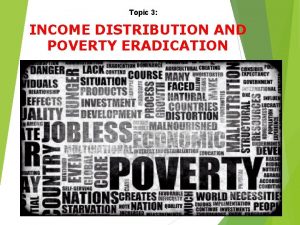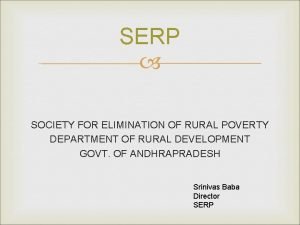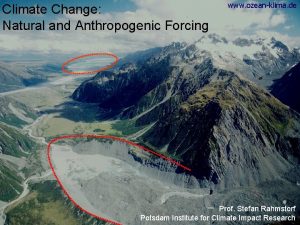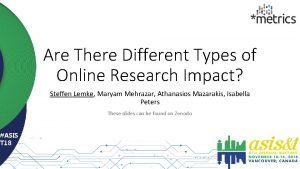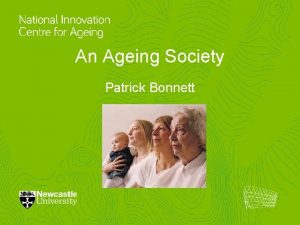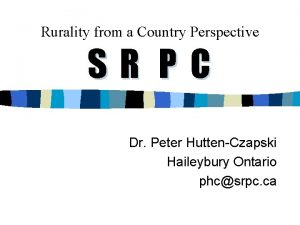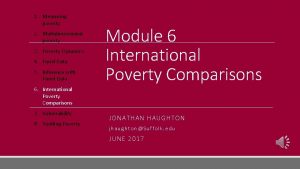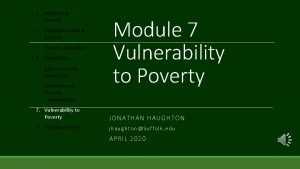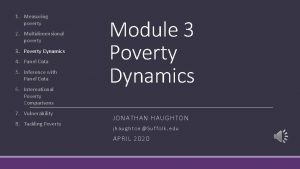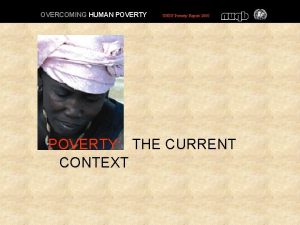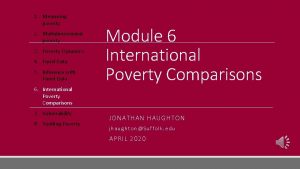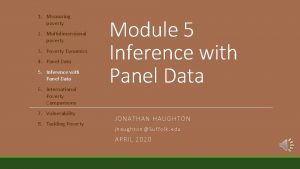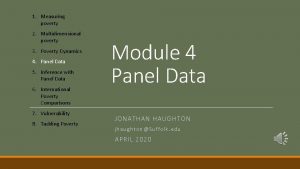Research Rural Poverty The Impact of rurality on














- Slides: 14

Research Rural Poverty: The Impact of rurality on consumers’ access to food, financial and digital services using a food poverty risk index ulster. ac. uk

Research Overview • The working aim – is an investigation to map and identify at risk areas that would benefit from food poverty/food access intervention. • It will use an innovative methodology of combining food poverty indicators with Geographic Information Systems (GIS) mapping to create an 'at risk of food poverty index'. The Food Poverty Risk Index will identify small scale areas within Northern Ireland that would benefit from poverty/food access intervention. In doing so, it will provide a solid foundation for targeting intervention programmes, where suitable, to improve the lives of rural dwellers, rural communities and rural businesses. • No other rural food poverty studies have investigated rural geographic access to food with structural poverty causation factors in this level of detail. The research is in its infancy and is therefore subject to evolve as it progresses through the first year

Research Objectives 1. To identify and map consumers’ access to food stores and emergency food aid services; 2. To identify and map consumers’ access to financial services; 3. To identify indicators/variables associated with food poverty to create a ‘food poverty risk index’ and to map the food poverty risk index across Northern Ireland to identify under-served areas in respect of food access; 4. To determine if rurality contributes to consumers’ sense of social exclusion; 5. To devise evidence-informed recommendations to support rural policymaking.

Background to the research ØEmergence from recessionary times. ØNI consumers fare worse than GB counterparts. ØRural sparisty - that is second only to Scotland; Ø Rural dispersed population Ø 37% of the NI citizens live in rural populations ØRelative and absolute poverty rates are slightly higher in rural areas than urban areas. ØWelfare Reform. ØBrexit.

Research Fit Policy Ø Draft Programme for Government Consultation Document (2016) ØNI Rural Development Programme (2014 -2020) ØNorthern Ireland Economic Strategy (2012 and pending) ØGoing for Growth Agri-Food Strategy (2013) ØEurope (2020) ØFitter Future for All (2012 -2022) ØMaking Lives Better (2013 -2023)

Research Design Stage 1 – Literature review/desk research ØReview existing body of literature. ØIdentify key characteristics of food poverty in NI. Ø Investigate the current actions/programmes/interventions being taken to tackle the issue of the food poverty. ØHighlight differences in approach. ØInterview key stakeholders.

Research Design Stage 2 – Mapping with Geographic Information Systems (GIS) ØGIS is a computer based programme that enables a wide range of geographic data to be integrated into a common framework. ØThe research will propose a range of indicators/variables relevant to food poverty for the creation of a ‘food poverty risk index’. ØThese variables will be weighted and combined into a final risk score for each Small Area across NI. ØGIS will be used to create a risk index of food poverty at Census Small Areas. ØSmall Areas consist of an average of 400 people and 155 households.

Research Design Stage 2 – Mapping Systems (GIS) with Geographic Information ØGIS Framework • Arranges layers of data to identify and interpret spatial relationships. Ø Relevant variables to food poverty ØFood Retailer Access ØFood Costs ØFood Aid ØFinancial Access ØDigital Access ØSocio-economic status ØHousehold type

Research Design Stage 2 – Mapping with Geographic Information Systems (GIS) Analyse Visualise Records/Stores Communicate GIS Framework

Houses within walking Supermarket 5, 10 and location 15 minute time from store walking from store

Research Design Stage 3 – Dissemination of results to key stakeholders ØResults will be targeted to key stakeholders. Ø Support organisations (Ci. NI, Trussell Trust, Fare. Share) Ø Food retailers and other resource providers Ø Public health Ø Government policy officials (Food Standards Agency) Ø Academics within the field ØShare potential pilot sites for targeted interventions. Ø Gain additional insights for the practical implications of the emerging recommendations.

Research Findings At risk of food poverty index Share research findings Target areas of deprivation Poverty alleviation policies and programmes Relevant intervention strategies Appropriate funding

Research Outcomes At risk food poverty index Measurable evaluation Allow progress monitoring High impact policies Reduce intergenerational poverty transmission Positive economic and social progressions

THANK YOU Mc. Clelland-N 1@ulster. ac. uk
 Distinguish between absolute and relative poverty
Distinguish between absolute and relative poverty Www serp ap gov in mobile bookkeeping
Www serp ap gov in mobile bookkeeping The potsdam institute for climate impact research
The potsdam institute for climate impact research Research impact and researcher identity
Research impact and researcher identity Ecrq journal
Ecrq journal Types of research impact
Types of research impact Hát kết hợp bộ gõ cơ thể
Hát kết hợp bộ gõ cơ thể Slidetodoc
Slidetodoc Bổ thể
Bổ thể Tỉ lệ cơ thể trẻ em
Tỉ lệ cơ thể trẻ em Chó sói
Chó sói Tư thế worm breton
Tư thế worm breton Hát lên người ơi
Hát lên người ơi Môn thể thao bắt đầu bằng chữ f
Môn thể thao bắt đầu bằng chữ f Thế nào là hệ số cao nhất
Thế nào là hệ số cao nhất
